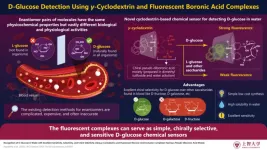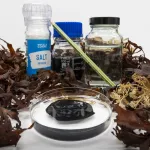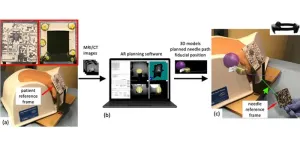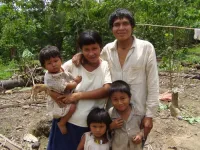(Press-News.org) Loss of muscle strength can be one of the most damaging outcomes when someone is unable to move a part of their body for a long period of time.
But a new Edith Cowan University (ECU) study may have found a way to offset or even protect against this — and it doesn’t even involve the affected body part at all.
Injury or illness may see a part of the body incapacitated for weeks or even months, causing unused muscles to weaken and lose their mass and strength, which can have a huge impact on people’s lives.
Lead researcher Professor Ken Nosaka noted it was already known gaining muscle strength in one limb due to resistance training will transfer to the same muscle on the opposite side of the body.
“This is known as the cross-education effect,” he said.
“However, the key aspect of this study is one particular type of muscle contraction proved most effective,” Professor Nosaka said.
The study
The research was a collaboration between ECU and Professor Trevor Chen from National Taiwan Normal University.
It saw 36 sedentary young men have their non-dominant arm immobilised by wearing a cast at their elbow joint for three weeks.
They were then split into three even groups: a concentric contraction group that lifted a dumbbell using the non-immobilised arm, an eccentric contraction group that lowered a dumbbell, and a control group that performed no exercises (see definitions below).
While their arm was immobilised, the concentric and eccentric groups had six weightlifting sessions twice a week, for three weeks.
These sessions would see them perform five sets of six dumbbell curls with a dumbbell corresponding to 20, 40, 40, 60, 60 and 80 per cent of their maximal strength over the six sessions.
Eccentric is best
When the cast was removed, the control group who did no exercises saw more than 15 per cent decreases in strength in the immobilised arm.
However, those who lifted weights saw little to no drop off in the immobilised arm’s muscle strength.
The concentric group saw muscle strength reduced to 4 per cent, but interestingly, muscle strength increased 4 per cent for the eccentric group, showing a stronger cross-education effect.
Researchers also measured the size of the muscle on the immobilised arm.
The control group saw muscle size decrease by around 12 per cent, whereas both concentric and eccentric muscle contractions with the opposing arm counteracted muscle atrophy in the immobilised arm.
Muscle size still decreased 4 per cent for the concentric group, while — remarkably — no decreases in muscle size were observed for the eccentric group.
Muscle damage protective effect
All participants were asked to perform 30 eccentric contractions with their immobilised arm once the cast was removed, with researchers measuring various muscle damage markers before, immediately following, and five days after the exercise.
The control group showed very severe muscle soreness and strength loss after the exercise, with the concentric group showing far less damage.
Again, the eccentric group saw the best results, providing a protective effect strong enough for peak muscle soreness to be reduced 80 per cent compared to the control group and 40 per cent of the concentric group.
Professor Nosaka said these results supported previous ECU research highlighting the benefits of eccentric exercise.
“We already know eccentric muscle contractions appear to be the most effective at promoting muscle strength and size gains — even in very small doses,” he said.
“It is important to investigate whether this latest study’s results are replicated for other muscles and whether eccentric resistance training is effective when dealing with immobilisation in real injuries, such as ligament sprains or tears, bone fracture, and post-surgery.
“However, healthcare providers can recommend resistance training — and eccentric contractions in particular — to minimise the negative effects of immobilisation and hopefully lessen its impact on people’s lives.”
‘Effects of unilateral eccentric versus concentric training of non-immobilize arm during immobilization’ was published in Medicine and Science in Sports and Exercise.
Definitions
There are three classifications of muscle contractions that relate to what the muscle is doing when being activated.
Concentric contraction - lifting the weight (muscle is shortening)
Eccentric contraction - lowering the weight (muscle is lengthening)
Isometric contraction - holding the weight parallel to the ground (muscle is stationary under load)
END
Can’t exercise a particular muscle? Strengthening the opposite side of your body can stop it wasting away
Loss of muscle strength can be a damaging outcome when someone is unable to move a part of their body for a long period of time. But a new study may have found a way to protect against this — and it doesn’t even involve the affected body part at all.
2023-03-02
ELSE PRESS RELEASES FROM THIS DATE:
Physical activity can help mental health in pre-teen years
2023-03-02
Regular physical activity can improve adolescents’ mental health and help with behavioural difficulties, research suggests.
Engaging in regular moderate to vigorous physical activity at age 11 was associated with better mental health between the ages of 11 and 13, the study found.
Physical activity was also associated with reduced hyperactivity and behavioural problems, such as loss of temper, fighting with other children, lying, and stealing, in young people.
Researchers from the Universities of Edinburgh, Strathclyde, Bristol, and Georgia in the United States explored data from the Children of the 90s study (also known as the Avon Longitudinal Study of ...
New fluorescent chiral-selective receptor system represents a breakthrough in molecular detection with potential for applications in diabetes management
2023-03-02
Diabetes mellitus, simply called diabetes, is a metabolic disorder characterized by the presence of abnormally high concentrations of glucose in blood. Existing methods for the diagnosis of diabetes rely on traditional techniques of detecting glucose in blood serum samples—a process that is typically tedious and expensive.
Molecular recognition is the science of accurately detecting specific compounds by exploiting their binding properties. Here, a receptor molecule–a kind of sensor–selectively binds to a target molecule. This process triggers some reaction, say, a change ...
Sleep too much or too little and you might get sick more, scientists find
2023-03-02
A good night’s sleep can solve all sorts of problems – but scientists have now discovered new evidence that sleeping well may make you less vulnerable to infection. Scientists at the University of Bergen recruited medical students working in doctors’ surgeries to hand out short questionnaires to patients, asking about sleep quality and recent infections. They found that patients who reported sleeping too little or too much were more likely also to report a recent infection, and patients ...
Study suggests EHR-focused interventions can significantly reduce unnecessary urine cultures among hospital patients
2023-03-02
Study Suggests EHR-Focused Interventions Can Significantly Reduce Unnecessary Urine Cultures Among Hospital Patients
Initiative highlighted in AJIC provides model for resource-limited institutions to decrease overdiagnosis and overtreatment of asymptomatic bacterial infections
Arlington, Va., March 2, 2023 – Physicians in the largest safety-net hospital system in the United States used two electronic health record (EHR)-focused interventions to significantly reduce inappropriate urine cultures among hospitalized patients. Findings from their study, published in the ...
Edible electronics: How a seaweed second skin could transform health and fitness sensor tech
2023-03-02
Scientists at the University of Sussex have successfully trialed new biodegradable health sensors that could change the way we experience personal healthcare and fitness monitoring technology.
The team at Sussex have developed the new health sensors – such as those worn by runners or patients to monitor heart rate and temperature – using natural elements like rock salt, water and seaweed, combined with graphene. Because they are solely made with ingredients found in nature, the sensors are fully biodegradable, making them more environmentally friendly than commonly used rubber and plastic-based alternatives. Their natural ...
Cocaethylene cardiotoxicity in emergency department patients with acute drug overdose
2023-03-01
Des Plaines, IL — When compared to cocaine exposure alone, cocaine and ethanol exposure in emergency department (ED) patients with acute drug overdose was significantly associated with higher occurrence of cardiac arrest, higher mean lactate concentrations, and lower occurrence of myocardial injury. This is the conclusion of a study titled, Cocaethylene cardiotoxicity in emergency department patients with acute drug overdose published in the February issue of Academic Emergency Medicine (AEM), the peer-reviewed journal of the Society for Academic Emergency ...
Free-hand, real-time needle guidance for prostate cancer diagnosis with augmented reality
2023-03-01
According to the US Centers for Disease Control and Prevention, prostate cancer is the second leading cause of cancer death among men. One of the standard approaches for the diagnosis and treatment of prostate cancer involves transperineal (TP) biopsy. This involves inserting a needle through the perineum wall to collect tissue samples. Current methods for TP biopsy generally include a pre-operation MRI scan and a transrectal ultrasound. These images are then fused together and shown on a monitor to the urologist, who then inserts the needle. The needle insertion can be ...
Special Selection
2023-03-01
A team of global experts has discovered new signals of natural selection in humans.
Led by UC Santa Barbara Tsimane Health and Life History Project co-director Michael Gurven, the team studied two populations living in the Bolivian Amazon rainforest — the Tsimane and the Moseten. Previous studies show that these tropical populations are exposed to many parasites and a variety of pathogens; at the same time, the Tsimane rarely suffer from cardiovascular diseases and dementia. This new research suggests that the Tsimane genome has undergone selection ...
Bronze Age well contents reveal the history of animal resources in Mycenae, Greece
2023-03-01
A large Bronze Age debris deposit in Mycenae, Greece provides important data for understanding the history of animal resources at the site, according to a study published March 1, 2023 in the open-access journal PLOS ONE by Jacqueline Meier of the University of North Florida and colleagues.
Animals were an important source of subsistence and symbolism at the Late Bronze Age site of Mycenae in Greece, as evidenced by their depictions in art and architecture, but more research is needed on the animals ...
What distinguishes fans from celebrity stalkers?
2023-03-01
A survey study of U.S. college students provides new insights into factors associated with the tendency to engage in celebrity stalking behaviors. Maria Wong (Idaho State University, U.S.), Lynn McCutcheon (North American Journal of Psychology, U.S.), Joshua Rodefer (Mercer University, U.S.) and Kenneth Carter (Emory University, U.S.) present these findings in the open-access journal PLOS ONE on March 1, 2023.
Celebrities around the world deal with the threat of unwanted and threatening or intimidating attention or harassment—commonly known as stalking. A growing body of research is exploring and identifying factors that are associated ...
LAST 30 PRESS RELEASES:
Study showcases resilience and rapid growth of “living rocks”
Naval Research Lab diver earns Office of Naval Research 2025 Sailor of the Year
New Mayo-led study establishes practical definition for rapidly progressive dementia
Fossil fuel industry’s “climate false solutions” reinforce its power and aggravate environmental injustice
Researchers reveal bias in a widely used measure of algorithm performance
Alcohol causes cancer. A study from IOCB Prague confirms damage to DNA and shows how cells defend against it
Hidden viruses in wastewater treatment may shape public health risks, study finds
Unlock the power of nature: how biomass can transform climate mitigation
Biochar reshapes hidden soil microbes that capture carbon dioxide in farmland
Reducing saturated fat intake shows mortality benefit, but only in high-risk individuals
Manta rays create mobile ecosystems, study finds
Study: Mixed results in using lipoic acid to treat progressive multiple sclerosis
Norbert Holtkamp appointed director of Fermi National Accelerator Laboratory
New agentic AI platform accelerates advanced optics design
Biologists discover neurons use physical signals — not electricity — to stabilize communication
Researchers discover that a hormone can access the brain by hitchhiking
University of Oklahoma researcher awarded funding to pursue AI-powered material design
Exploring how the visual system recovers following injury
Support for parents with infants at pediatric check-ups leads to better reading and math skills in elementary school
Kids’ behavioral health is a growing share of family health costs
Day & night: Cancer disrupts the brain’s natural rhythm
COVID-19 vaccination significantly reduces risk to pregnant women and baby
The role of vaccination in maternal and perinatal outcomes associated with COVID-19 in pregnancy
Mayo Clinic smartwatch system helps parents shorten and defuse children's severe tantrums early
Behavioral health spending spikes to 40% of all children’s health expenditures, nearly doubling in a decade
Digital cognitive behavioral treatment for generalized anxiety disorder
Expenditures for pediatric behavioral health care over time and estimated family financial burden
Air conditioning in nursing homes and mortality during extreme heat
The Alps to lose a record number of glaciers in the next decade
What makes a good proton conductor?
[Press-News.org] Can’t exercise a particular muscle? Strengthening the opposite side of your body can stop it wasting awayLoss of muscle strength can be a damaging outcome when someone is unable to move a part of their body for a long period of time. But a new study may have found a way to protect against this — and it doesn’t even involve the affected body part at all.





